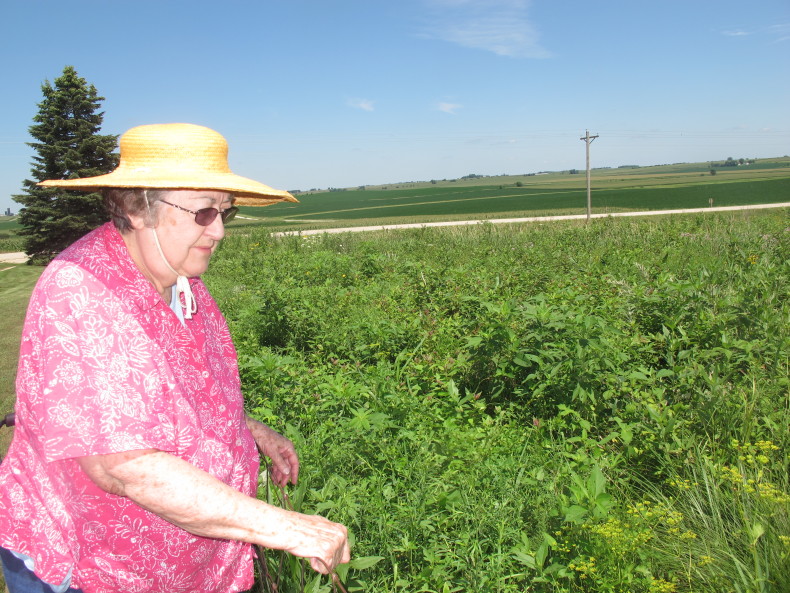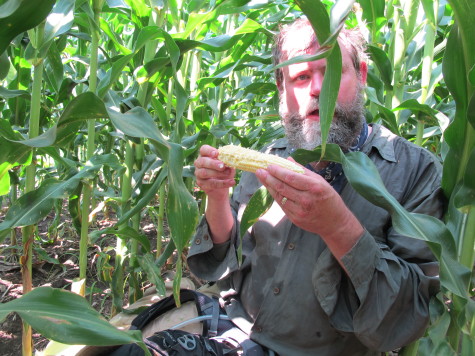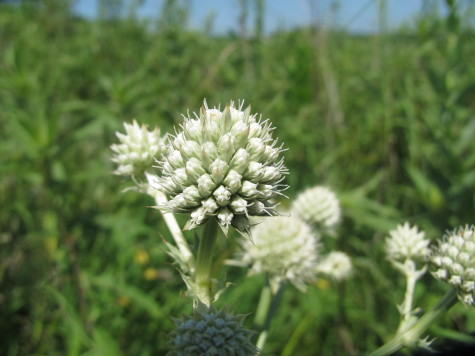This post comes from 2015, which seems like lifetimes ago, and I don’t know what happened to the woman I interviewed or this small patch of earth in Iowa she was defending. I’ve often turned to this memory as a sign of hope in a decaying natural world, one person focusing her life on one small tangle of green in an empire of monoculture.
A summer not long ago I went for a grueling 3-day backpack through GMO cornfields in Iowa, camping among walls of waxy green leaves that sawed against each other in the breeze. I wanted to see what besides corn and soybeans lived out here. Not much, I found. Spiders and ants were few and only the smallest species survived. There were some mushrooms, but not many, and I happened into a whitetail deer one night. Otherwise, it was a catastrophic biological landscape, as if a bomb had gone off killing almost everything but a couple engineered species.
Thrashing out of the hot, dripping fields, my skin coated in sweat and grimy soil the consistency of shoe polish, I set off looking for signs of biologic hope in the area. I ended up at small patch of what is called virgin prairie, a plot of ground near the forgotten town of Butler Center where crops had never been planted. The town itself was gone, plowed under and turned into rows of corn, while this plot called the Clay Hills Preserve had been set aside. No plow had ever touched the ground.
Ruth Haan, a woman in her eighties, was one of the last on a board of volunteers overseeing the preserve. Locals warned me that Haan was losing her mental faculties. Her niece who drove her to the site to meet me on a blistering summer day said right in front of her that she was getting a little loopy.
“Oh, honey, I just need a little help now and then,” Haan said in her sundress, the fat of her arms hanging like handbags.
Haan pushed her wheeled walker across bumpy ground to reach the fence marking the refuge that she’d known her entire life. “Volunteers haven’t met for quite a while because most of us have died,” she said. “I sure hope someone will keep an eye on this after I’m gone. It’s the last piece around.”
On the other side of an old tangle-wire fence stood a waist-high briar of shrubs, grasses and flowers. It was not purely native by any stretch, but it was virgin, unplowed. If I hadn’t been pushing my way through monotonous parrot-feather green fields of corn for the last few days, this would have looked like a wild and forgotten lot, something you might mow down just to get the plants out of the way. Instead, to me it looked like a small paradise, horizons of corn and soybeans hemming it in on all sides.
Haan wore a yellowed straw sun hat and I could see her wearing that thing for years on her knees out here in the sun pulling up weeds. She stopped at the fence and said, “Smells good, doesn’t it?”
It didn’t smell like corn, I knew that.
With liver-spotted hands she pointed at a plume of fine grass and said, “When you find dropseed, you know it’s virgin; they didn’t plow it up. Wild parsnip, not native, shouldn’t be in there. Some of these shrubs and yucky stuff – that grass over there is invasive. It’s not supposed to be here, and, oh, nettles, nettles, that’s a shame. But, oh, look there, rattlesnake master.” She pointed at a plant bearing prickly greenish-white balls of flowers. Pioneers believed its roots could be used to cure rattlesnake bites.
“It’s a wonder it’s still here,” Haan said. “That makes me feel good to see that.”
I helped her along, holding her hand as she stepped from the walker and leaned against the fence, grabbing wire as she looked more closely at the rattlesnake master. “I wish it was prettier for you,” she said. “It’s pretty for me.”
Biologists I spoke with had little to say about such a small plot as the Clay Hills Preserve. They saw it as genetically indistinct, a drop in the bucket when looking at much larger habitat fragmentation, 90 percent of Iowa turned to cropland around it. This plot was hardly half an acre and Haan was no scientist, her eye more aesthetic than empirical. Still, I tried to understand what drove her to protect this place. In the big scheme, would it even matter? She thought my question was nonsense, as if it should be plain as day that a place like this matters.
I later spoke with the eminent biodiversity scientist Edward O. Wilson, mentioning Haan’s plot and other small preserved pieces of ground I encountered in Iowa. Wilson called much of what I saw artificial assemblages. When I told him I found an actual forest set aside as wildlife habitat in the middle of several corn fields, he asked, “Was it really a forest?”
In other words, were any of those trees part of an original ecosystem, or was its just a manufactured island of plant life, a mishmash anomaly that plays hardly a role in the bigger biological picture of the earth? I argued politely with Wilson saying, But there was diversity, there were birds!
Wilson told me about visiting a similar place in his homeland in Alabama where a heavily disturbed longleaf pine ecosystem had recently grown back in, many plants competing for sunlight. He said, “I thought it looked great. You know, it looked like a real, wild place.” But a botanist with him, one who worked in the area, told him that no, it wasn’t, saying that the floral diversity was actually quite low. Wilson said to the botanist, “Of course it will come back.” The botanist said no, he didn’t think so, not anytime soon.
Wilson said, “There is no such thing as rejuvenating a place by eliminating biodiversity, then letting biodiversity flow back in. We don’t have the millions of years that would take, it’s as simple as that.”
In the minds of many biologists, Haan’s plot is better than nothing but not by much. It is hardly more than a backyard garden. But slowly walking with Haan, I came to understand that it represents a fundamental human need. As much as we tend to fragment and destroy life around us through industrial action, there is also a drive to preserve diversity and prevent the destruction of every last thing. Without that drive, I fear the circumstance would be much worse. The site may have been genetically irrelevant, protected out of some sentimental urge, but it was a sign of action, a place where the longing for diversity could find at least a toehold. Instead of countless other possible hobbies, Haan was putting her life into one piece of virgin prairie.
With eyes sore from waves upon waves of corn, to me, it was like finding a remnant of Eden. When she said how good it smelled, I had to agree. It finally smelled like life.
Photos by Craig Childs (except for the one taken by the poor soul who joined me on the trek).



I’ve read this before and can’t remember where or whether I left a comment. I used to have a recurring nightmare of the entire earth developed, under concrete for the convenience of humans. Except for very rare perfect squares of flora behind tall chain-link fences. In my dream I am standing against the fence, trying to merge into the scent of the plants just beyond arm’s reach. There are no animals, no birds or insects to be seen or heard. A man nearby explains that no one is allowed inside, this is all that’s left. And I would wake in a panic. Thank you, Craig, for noticing and for caring.
. But a tiny bit of hope to cling to…
A half acre may not be much, but it’s something! Certainly to that Rattlesnake Master and their relations. I’m all for reveling and championing micro-scale and vast(er) landscape conservation. Not sure it really needs to be an either/or sort of construct at this point; though I appreciate E.O. Wilson’s frame of reference. Today, it’s what we’ve got, so lets celebrate! Let’s celebrate the quiet people like this woman and her fellow board members for protecting and caring for Clay Hills Preserve! This story reminds me a bit of Discovery Park in Seattle. Today it’s the city’s largest park, but some 60 years ago it was still a military base and Nike missile site. Today parts of the park that are insight of the old launch pad, now support some of the highest bird diversity in the city. This is in part thanks-be to the tenacity of life. Also thanks-be for the help of quiet people, like retired high school history teachers, who volunteered for the last 40 years to plant and tend an assortment of native species. Here’s to rewilding Eden and sustaining her remnants.